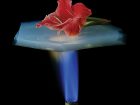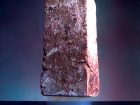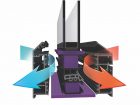
Articles
Fabrication
Frozen smoke – The promise of aerogels in window manufacturing
Some window manufacturers are capitalizing on the remarkable properties of aerogel.
July 3, 2019 By Carroll McCormick
If you ever find yourself in the Yale Sculpture Building in New Haven, Conn., look closely at the translucent wall panels. They contain an almost weightless, yet super-insulating material with a U-factor of just 0.05. It is called aerogel.
Had the panels been fabricated with a simple air gap alone, the U-factor would have been 0.50, and ones filled with proprietary glass fiber insulation 0.23 to 0.10, according to Sam Keller, the creative director for Manchester, N.H.-based Kalwall, which built the panels.
Aerogel – made from gel but not itself a gel – was invented by the American scientist and chemical engineer Samuel Stephens Kistler, which he announced in a 1931 paper published in Nature called “Coherent Expanded Aerogels and Jellies.”
Sometimes referred to as frozen smoke, because that is what a block of it looks like, it is said to be the lightest solid ever made. While its weight varies according to the manufacturing process and the material used (most typically silica), Guinness World Records lists a graphene aerogel as the world’s least dense solid, at 0.16 milligrams per cubic centimeter, or 160 grams per cubic meter.
Aerogel is 99.8 per cent air, yet it is structurally pretty strong. NASA has a photo of a 2.5-kilogram brick sitting on a two-gram piece of aerogel. Press on it a bit, and nothing happens. Press very firmly and it will shatter like glass.
It has been used in various ways: thickening agents in cosmetics and in spacecraft to trap space dust. But its real claim to fame is its excellent insulating properties. NASA has used it to insulate space suits and the Mars Rover. More pedestrian products include cycling gloves and thermal sports bottles.
But for its high cost and opacity (researchers are working to solve this problem) perhaps it would be the insulating material of choice in windows. But at least two window manufacturers, Kalwall and Buckinghamshire, England,-based Origin Frames do use it.
Kalwall makes museum-quality facades, skyroofs, skylights, canopies and walkways. The goal is to transmit perfectly diffused light that mimics the transmission of the sun. While its aerogel-containing systems are translucent, the aerogel blocks none of the visible wavelengths of the electromagnetic spectrum. “[You are] seeing the true colour fidelity,” Keller says.
“It is a niche product for us. We’ve done over 1,000 applications. The only real barrier to entry is the price point,” Keller says. Systems with their aerogel option cost two to three times more than their conventional systems.
In some cases though, performance wins out over price. “Most aerogel customers are looking to design the highest performance building envelopes possible. They may be designing for LEED, BREAM, Net Zero, Passive House or other voluntary green standards that exceed minimum energy code requirements. Buildings are typically for commercial, institutional and/or governmental entities that think more about life cycle costs and want to demonstrate leadership in sustainable building practices,” Keller explains.
As for its translucency, Keller points out that while vision glazing is great at letting in light, it is not good at much else. “Glass is especially ill-suited to skylights, particularly large top-lighting applications, because it allows too much heat gain, not enough thermal insulation, plus glare and areas of high contrast. Overuse (floor to ceiling) is not necessary and tends to produce negative side effects that must be mitigated by secondary light control and HVAC building systems.”
Kalwall has been selling aerogel-containing systems since about 2003. Keller’s grandfather and company founder brought aerogel into the company; the company lays claim to having invented the translucent structural sandwich panel.
“Aerogel was his ideal material for a light-transmitting, super-insulating, lightweight material to integrate into his translucent panel design. He developed his own patented aerogel formulations, but those have never been manufactured at a large scale. Kalwall partnered with Cabot Industries to offer the first commercially available fenestration system [using aerogel] in the early 2000s. The brand name is Lumira,” Keller says.
Kalwall is not insulated glass, Keller explains. “We make a totally different product. It is fibreglass-reinforced polymer. The exterior face sheet is 0.07 inches thick and the interior pane is 0.045 inches thick, bonded to a structural grid core. In each of the spaces – cells – within the grid core we place insulation. We are part way between a wall and a panel.”
When aerogel is specified, Kalwall uses a granular aerogel, Keller says. “Aerogel granules are vastly less expensive than monolithic optically clear block or sheets of the material, which to my knowledge no one produces at a commercial scale even to this day.
“Since our panels transmit light, we require the highest commercial grade of granular aerogel that has no optical or colour defects. Lesser grades can be used for niche industrial applications where light transmission is not required and minor imperfections will not be seen.”
Origin, on the other hand, exploits aerogel’s excellent thermal properties to provide additional levels of thermal break insulation in its premium aluminum windows. It has been offering aerogel in its products globally for about seven years. “[The use of] aerogel was really driven by strict thermal codes in Europe,” says Ben Halvorsen, president of Origin USA.
Origin uses an aerogel that, combined with needled backing fibres, makes a flexible and resilient blanket. Its use as a thermal break yields a U-factor as low as 0.3 in a double-glazed window and as low as 0.15 in a triple-glazed window, according to Origin. The company asserts that aerogel improves a window’s overall thermal efficiency by 67 per cent.
When aerogel is not selected, the windows are manufactured with a polyamide thermal break, offering a U-factor of 0.34. While the difference between 0.30 and 0.34 sounds small, Halvorsen notes that, “This can be the difference between meeting energy codes or not.”
Halvorsen values the lower weight of aerogel and the sense of environmental responsibility that motivates clients that choose the aerogel option. “Aerogel is the lightest solid in the world, which can be important when weight is an issue.”
In somewhat the same way that some people happily pay a premium for electric cars, some will pay more for better insulated windows, Halvorsen says. “What sells aerogel is that we are very environmentally sensitive. Saving $50 a month does not sell aerogel.”
Thermal efficiency is not just based on keeping cold out. Origin has customer bases in hot countries, like Dubai, where keeping homes cool is the main challenge. “It costs more to cool a home than to heat one. This is a tremendous burden on the planet,” Halvorsen says. As a side note to the improvements being missed by not making the use of aerogel more widespread, he adds, “We have not yet found a local authority that demands aerogel.”
Cost has been a disincentive to the widespread adoption of aerogel in the window industry, but so have insufficiently challenging code requirements and a simple lack of awareness of aerogel’s existence.
“Today there is still a mismatch between what most energy codes require for fenestration and the cost of aerogel. There is also the primacy of glass and vision glazing. There is just not a huge incentive to adopt widespread use of aerogel if the goal is simply to meet code and contain costs,” Keller says.
Halvorsen believes that window designers are not pushing the innovation envelope hard enough. “We should be challenging one another. We recently came out of the International Builders Show in Las Vegas. The consensus was that there was nothing new in the industry. I think that is a real shame. It reflects a lack of drive and innovation in the industry.”
It may be more a lack of awareness than disinterest that lies behind aerogel not becoming a more mainstream solution for improving the thermal performance of windows. Halvorsen recalls a luncheon of architects at which Origin was giving a course it called “Structural, Thermal and Environmental Material Performance for Today’s Doors and Windows,” for American Institute of Architects Continuing Education Systems credit.
“For the first time, we saw 150 architects sit up and pay attention. This is so really cool. Very few industry experts are aware of aerogel. We have probably been remiss in not announcing our use of aerogel to the world,” Halvorsen says.
Tougher building codes might force a cost showdown between simply adding more panes of glass, say, and using aerogel. “Hopefully, as energy codes for fenestration strengthen, adoption will increase and prices will fall,” Keller says. “High-performance insulated glass can only improve so much. Other approaches, including designing with more translucent, aerogel-integrated products will be required to achieve superior building envelope performance.”
According to David Cooper of Guardian, researchers may not be far from reducing the opacity of aerogel to the point where it is useable as a fill in insulating glass. Cooper says aerogel-filled IG units conduct heat as if they have an R10 insulating factor. Combined with aerogel in the frame and other high-performance materials, it could be possible to construct a window that competes with the wall itself for thermal transmission performance.
Print this page




Leave a Reply